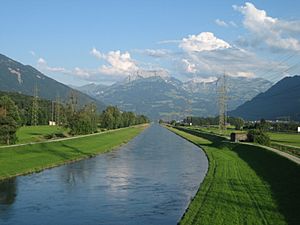Linth facts for kids

The Linth is a Swiss river that begins high in the mountains near the village of Linthal. It flows through the canton of Glarus and eventually reaches the Obersee, which is part of Lake Zurich. This river is about 50 kilometers (31 miles) long.
Long ago, the textile industry in the Glarus region grew because it could use the Linth's powerful water to run its machines. Even today, the river helps create electricity for the Linth–Limmern power stations located in its upper parts. The Linth river and its upper valley also form a natural border between two mountain ranges: the Glarus Alps to the east and south, and the Schwyzer Alps to the west.
Contents
What is the Linth River?
The Linth is an important river in Switzerland. It starts in the canton of Glarus and flows north. Its journey ends when it joins Lake Zurich. The river is known for its strong current, especially in the mountains.
Where Does the Linth River Start?
The Linth river begins its journey in the high Alps of Switzerland. Its source is close to the small village of Linthal. This area is very mountainous and beautiful.
How Long is the Linth River?
From its start in the mountains to where it flows into Lake Zurich, the Linth river stretches for about 50 kilometers. That's roughly 31 miles, which is a good distance for a mountain river!
How the Linth River Helps People
The Linth river has been very useful to the people living near it for a long time. It has helped with jobs and power.
Powering Old Industries
In the past, the Linth river was super important for factories. The fast-flowing water provided energy for the textile industry in the canton of Glarus. This meant that machines could spin thread and weave fabric using the river's natural power.
Generating Electricity Today
Even now, the Linth river is still a source of power. In its upper sections, the river helps run the Linth–Limmern power stations. These stations use the river's flow to create electricity for homes and businesses.
The Linth River as a Natural Border
The Linth river doesn't just flow; it also acts as a natural dividing line.
Separating Mountain Ranges
The river and the valley it flows through create a clear boundary. To the east and south of the river are the Glarus Alps. To the west, you'll find the Schwyzer Alps. This makes the Linth a natural landmark between these two big mountain areas.
Images for kids
-
The plain of the Linth between Weesen and Schmerikon before and after the correction of the Linth, 1811
See also
 In Spanish: Río Linth para niños
In Spanish: Río Linth para niños



